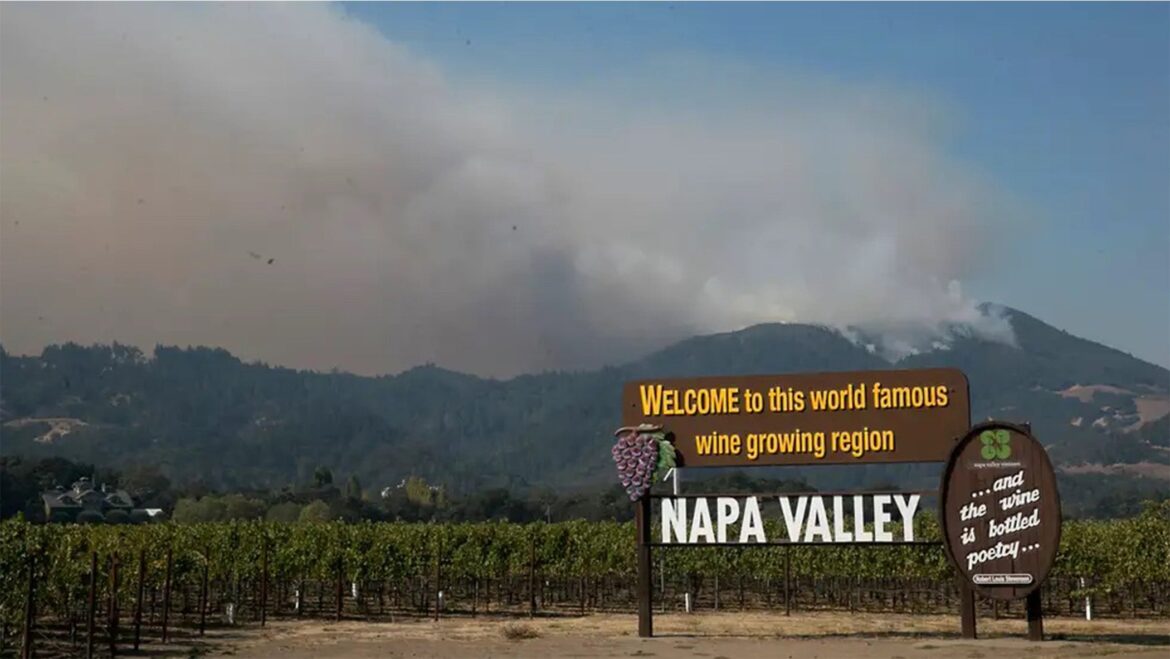Can Wildfire Smoke Ruin Napa Wine Grapes?
As Northern California endures an intense 2025 wildfire season, experts warn the impact could extend far beyond scorched land and smoke-filled skies: It could seep directly into the glass of wine on your dinner table.
“When you get these compounds coming from the smoke, they actually get integrated into the winemaking process, particularly for red wines,” explained Burak Kazaz, Professor of Supply Chain Management at Syracuse University and founder of the field of Wine Analytics. “After fermentation they start releasing smoky, ashy, almost like cigarette or medicine-type flavors. That’s when we understand this is actually a smoke tainted wine.”
Smoke taint is top of mind for winemakers this harvest season, particularly in Napa Valley, where the Pickett Fire has burned thousands of acres near Calistoga. The timing could not be worse. “The most risky period is what we call veraison” said Kazaz of the weeks leading up to the usual September/October harvesting season. “So if you have a wildfire like today, then you’re more likely to be exposed to smoke taint in your production.”
Weather in your inbox
By signing up you agree to the Terms & Privacy Policy. Unsubscribe at any time.
Winemakers on the ground echo those concerns. “Smoke taint can overpower the wine’s natural fruit and terroir characteristics, significantly reducing its overall quality, market value, and drinkability.” said Shaun B. Coleman, owner and vintner at Alamitos Vineyards in San Jose. “In severe cases, it renders the wine unsellable.”
(MORE: Pickett Fire In California Threatens Napa Vineyards)
Not all wines are equally vulnerable to smoke taint. Red wines tend to be most affected because their production involves extended contact between the juice and the grape skins, where smoke compounds linger. This means varietals like Cabernet Sauvignon, Syrah and Zinfandel can garner stronger burnt flavors if exposed. White wines and rosés, on the other hand, are often less impacted, since the juice is separated from the skins quickly after harvest.
For premium producers, even a hint of smoke can be devastating. Vintners got lucky in 2017, when the record-breaking Tubbs Fire was sparked just after grapes had been harvested for the season. Just three years later, 2020’s wildfire season caused premium winemakers to abandon that year’s vintage altogether.
Coleman pointed to similar risks this year. “Absolutely, winemakers in Napa have valid concerns about the Pickett Fire,” he said. “Proximity to vineyards heightens the risk of smoke taint, especially if winds carry smoke over grapevines for extended periods at ground level. Even at Alamitos Vineyards down in San Jose, (nearly 90 miles from Napa) we’ve felt the indirect effects of Napa-area fires in previous years.”
(MORE: Invisible Scars From Maui, LA Wildfires)
Beyond quality, the economic and supply chain effects ripple outward. Kazaz noted that “wineries generate a lot of tourism revenue for the Napa region, around $300 million in Calistoga particularly. That basically has to be halted because of the safety of visitors, safety of the workers (and) safety of the production facility.”
Vineyards are developing strategies to reduce risks, though none are foolproof. Coleman described a multi-step approach:
Applying protective sprays or clay-water mixtures, which create a barrier on grape skinsTechniques like reverse osmosis or activated carbon filtrationIf smoke is imminent, some vineyards will opt for early harvestingPost-exposure lab testing to help guide final decisions on a tainted product
(MORE: Sunscreen For Wine?)
At Alamitos Vineyards, that preparation includes firefighting equipment. “We’ve gone further by purchasing an old retired wildland fire truck in 2017 due to our wildfire worries,” Coleman said. “In 2018 and 2019, we used it alongside CalFire to battle two fires on our property, successfully preventing spread.”
Ultimately, both experts agree that climate change is making fire a permanent part of the California wine story. “This is actually a tragedy, this is happening very frequently,” Kazaz said, citing an increase in the number of fires and rising temperatures prolonging wildfire season. “California will be more prone to these kinds of risks.”
(MORE: Climate Change Could Put Bananas In Jeopardy)
Coleman, too, sees the stakes rising: “Beyond smoke taint, wildfires pose multifaceted threats to the wine industry, including direct physical damage to vines, irrigation systems, and infrastructure, which can destroy entire vineyards requiring replanting, and can take up to 5 years to produce wine quality grapes again.”
For California’s winemakers and wine lovers, the 2025 vintage is still hanging in the balance. The true impact of the Pickett Fire won’t be fully understood for months — or even years — until bottles finally reach the shelves.
Weather.com lead editor Jenn Jordan explores how weather and climate weave through our daily lives, shape our routines and leave lasting impacts on our communities.



Dining and Cooking